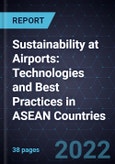All the leading airports across the world are focusing on environmental objectives and sustainability to achieve the United Nations' Sustainable Development Goals.
This research service examines airport sustainability in 2021 and evaluates its prospects in the ASEAN region. Sustainability best practices for Changi Airport Group, Malaysia Airports, and Airports of Thailand are discussed, and the social, economic, and environmental aspects of sustainability at airports are analyzed.
The social aspect focuses on the creation of job opportunities and the improvisation of airports' brand equity; moreover, if training centers are set up, employee morale and productivity will be boosted and conflicts between airport operators and communities in proximity to airports will decrease. The environmental aspect highlights the curbing of carbon emissions through the use of renewable sources of energy; it also emphasizes that air and water quality can be improved by planting trees and using water filters. Nevertheless, if airports' sustainability plans are to become economically viable, airports will have to increase the airport development fee. They will also have to reduce long-term liabilities through cost savings on energy and infrastructure development and decrease operating and maintenance costs.
Prime drivers for sustainability projects are improved brand equity, increased employment opportunities, and an increase in nonaero sources of revenue, while the restraints are the allocation of a separate budget for sustainability projects and the lack of government focus on sustainability in developing countries.
Emerging technologies such as IoT, AI, and robots will help airports reach their sustainability goals. IoT can be used to improve air quality by reducing nitrogen oxide emissions; AI can lessen traffic in cargo terminals and optimize cargo operations; and robots can track waste management, organic farming, and energy generation through solar panels.








